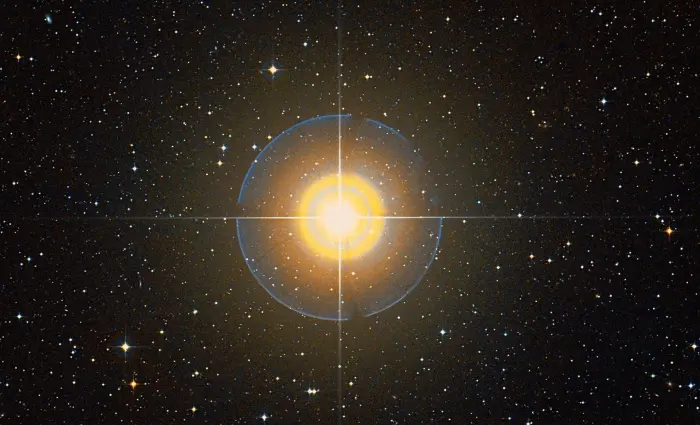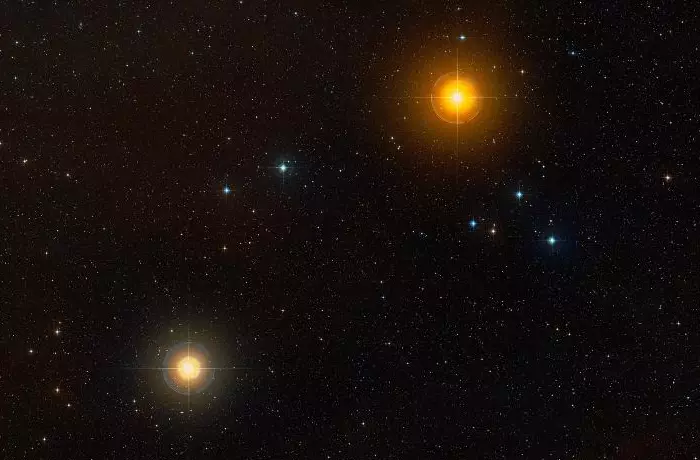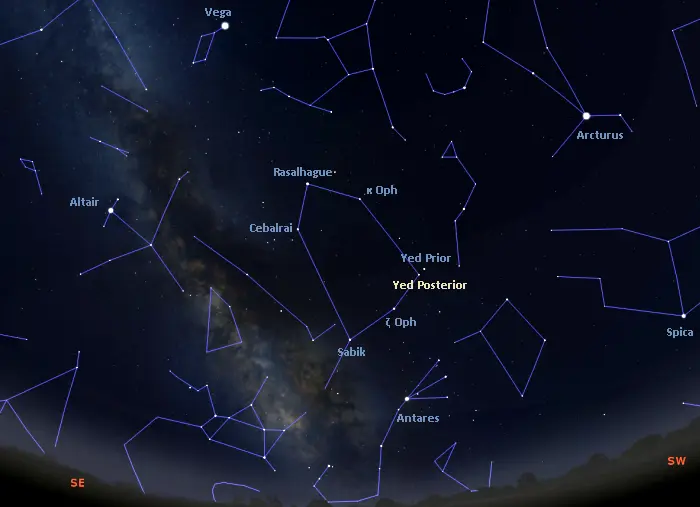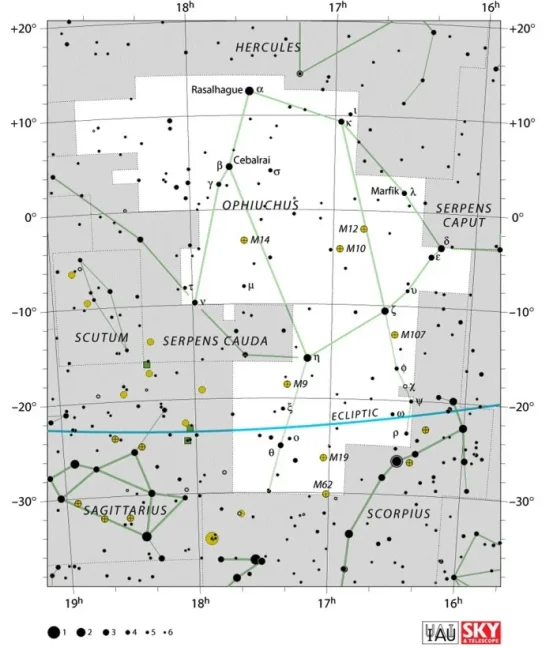Yed Posterior, Epsilon Ophiuchi (ε Oph), is a G-type red giant located 106.9 light-years away in the equatorial constellation Ophiuchus. With an apparent magnitude of 3.220, it is the seventh brightest star in the constellation. It forms a visual pair with the brighter Yed Prior (Delta Ophiuchi). The two stars mark the left hand of the celestial Serpent Bearer.
Star type
Yed Posterior is a red giant with the stellar classification G9.5 IIIb. It has a mass of 1.85 solar masses and a radius 10.39 times that of the Sun. With an effective temperature of 4,918 K, it is 54 times more luminous than the Sun. The star has an estimated age between 0.95 and 1.01 billion years.
A study published in 1991 reported that Epsilon Ophiuchi was cyanogen and carbon deficient. Cyanogen deficiency is unusual in G- and K-type giants and indicates that Yed Posterior belongs to a population of stars older than the Sun, one found in the Milky Way’s thick disk. For this reason, the star is also somewhat deficient in carbon.
In 2012, the star’s outer envelope was found to exhibit solar-type oscillations with a period of 0.19 days. The astronomers who reported the oscillations measured a limb-darkened angular diameter of 2.961 ± 0.007 milliarcseconds. They derived a photospheric radius of 10.39 ± 0.07 solar radii and a mass of 1.85 ± 0.05 solar masses.

Yed Posterior (Epsilon Ophiuchi), image: Wikisky
Facts
In Arabic astronomy, Yed Posterior formed an asterism known as the Southern Line or the Southern Boundary (al-Nasaq al-Yamānī) with Yed Prior (Delta Ophiuchi), Unukalhai (Alpha Serpentis), Delta Serpentis, Epsilon Serpentis, Zeta Ophiuchi, and Sabik (Eta Ophiuchi). Sabik, Zeta Ophiuchi, Yed Prior and Yed Posterior are the stars that form the base of the polygon asterism that makes the constellation Ophiuhus recognizable. The Serpens stars appear along the same line, to the right of the Ophiuchus stars. The Northern Line was formed by Kornephoros (Beta Herculis) and Gamma Herculis with Beta and Gamma Serpentis. The stars between the two lines marked a pasture and sheep guarded by a shepherd (Rasalhague).
Name
The name Yed Posterior (pronunciation: /ˌjɛd pɒˈstɪəriər/) is derived from the Arabic yad, meaning “hand.” The word posterior is Latin for “coming after.” It refers to the fact that Epsilon Ophiuchi follows the brighter Delta Ophiuchi (Yed Prior) across the sky. Yed Posterior is the eastern of the two stars.
Yed Prior and Yed Posterior mark the left hand of Ophiuchus that holds the head of the Serpent. The hand that holds the tail is represented by the fainter Nu Ophiuchi, traditionally called Sinistra.
The name Yed Posterior was approved by the International Astronomical Union’s (IAU) Working Group on Star Names (WGSN) on October 5, 2016.

Yed Prior and Yed Posterior (Delta Ophiuchi and Epsilon Ophiuchi), image: Wikisky
In Chinese astronomy, Yed Posterior was called 天市右垣十 (Tiān Shì Yòu Yuán shí), the Tenth Star of Right Wall of Heavenly Market Enclosure. The Right Wall asterism represented the ancient states of China and Yed Posterior was associated with the state Chu. The asterism was also formed by Yed Prior (Delta Ophiuchi), Kornephoros (Beta Herculis), Gamma Herculis, Marsic (Kappa Herculis), Gamma Serpentis, Beta Serpentis, Unukalhai (Alpha Serpentis), Delta Serpentis, Epsilon Serpentis, and Zeta Ophiuchi. It was part of the Heavenly Market Enclosure, which represented the emperor’s realm.
Location
Yed Posterior lies in the eastern part of Ophiuchus, near the border with Serpens Caput. It appears 04° 33’ south of the celestial equator and forms a visual pair with Yed Prior. Both stars are easy to identify because they are part of the large polygon that makes Ophiuchus recognizable. Yed Prior marks the southwestern vertex of the polygon and Yed Posterior appears just right of its brighter neighbour.
The stars are found north of the Scorpion’s claws. Rasalhague, the star at the top of the polygon, appears roughly halfway between Antares in Scorpius and Vega in Lyra. Other bright stars that form the polygon asterism are Sabik, Zeta Ophiuchi, Cebalrai, and Kappa Ophiuchi.
Sabik, Zeta Ophiuchi, Yed Posterior, and Yed Prior form a relatively straight line that is extended into the neighbouring Serpens by Epsilon Serpentis, Unukalhai (Alpha Serpentis), and Delta Serpentis.

The location of Yed Posterior, image: Stellarium
Constellation
Yed Posterior is located in the constellation Ophiuchus. Associated with the god Apollo and the healer Asclepius in Greek mythology, the celestial Serpent Bearer is the 11th largest constellation in the sky. It occupies 948 square degrees of the sky on the celestial equator. As one of the 15 equatorial constellations, it is visible from virtually any place on Earth.
Ophiuchus is one of the ancient Greek constellations, catalogued by the Greco-Roman astronomer Claudius Ptolemy in his Almagest in the 2nd century CE. It divides the neighbouring constellation Serpens into two parts: Serpens Cauda (the Serpent’s Tail) and Serpens Caput (the Serpent’s Head).

Ophiuchus constellation map by IAU and Sky&Telescope magazine
Ophiuchus is relatively bright, hosting five stars brighter than magnitude 3.0. While it does not contain any first-magnitude stars, the constellation is easy to identify because its five brightest stars form a large polygon just north of the Fish Hook in Scorpius. Rasalhague (Alpha Ophiuchi), the constellation’s brightest star, is a white giant that shines at magnitude 2.07 from a distance of 48.6 light-years. Ophiuchus is also home to Barnard’s Star, the second nearest star or star system to the Sun (after Alpha Centauri).
Other notable stars in the constellation include Zeta Ophiuchi, the nearest O-type star to the solar system, the recurrent nova RS Ophiuchi, the double star Sabik (Eta Ophiuchi), the nearby red dwarf Wolf 1061, and the massive star system Rho Ophiuchi, surrounded by the Rho Ophiuchi molecular cloud, one of the nearest stellar nurseries to the Sun.
Ophiuchus hosts many notable deep sky objects. They include the bipolar planetary nebula M2-9, better known as Minkowski’s Butterfly or the Twin Jet Nebula, the Dark Horse Nebula, Kepler’s Supernova, the Starfish Galaxy (NGC 6240), and the open clusters IC 4665 (the Hi Cluster) and NGC 6633 (the Tweedledum Cluster). Bright globular clusters in the constellation include Messier 9, Messier 10, Messier 12, Messier 14, Messier 19, Messier 62, and Messier 107.
The stars and deep sky objects of Ophiuchus are best observed in the month of July, when the constellation dominates the evening sky. The entire constellation can be seen from locations between the latitudes 80° N and 80° S.
The 10 brightest stars in Ophiuchus are Rasalhague (Alpha Oph, mag. 2.07), Sabik (Eta Oph, mag. 2.43), Zeta Ophiuchi (mag. 2.569), Yed Prior (Delta Oph, mag. 2.75), Cebalrai (Beta Oph, mag. 2.75), Kappa Ophiuchi (mag. 3.20), Yed Posterior (Epsilon Ophiuchi, mag. 3.22), Theta Ophiuchi (mag. 3.26), Nu Ophiuchi (mag. 3.332), and 72 Ophiuchi (mag. 3.73).
Yed Posterior – Epsilon Ophiuchi
| Spectral class | G9.5 IIIb |
| U-B colour index | +0.762 |
| B-V colour index | +0.972 |
| Apparent magnitude | 3.220 |
| Absolute magnitude | +0.55 |
| Distance | 106.9 ± 0.7 light-years (32.8 ± 0.2 parsecs) |
| Parallax | 30.5136 ± 0.1878 mas |
| Radial velocity | –9.342 ± 0.0009 km/s |
| Proper motion | RA: + 83.916 ± 0.207 mas/yr |
| Dec.: + 40.763 ± 0.181 mas/yr | |
| Mass | 1.85 ± 0.05 M☉ |
| Luminosity | 54 L☉ |
| Radius | 10.39 ± 0.07 R☉ |
| Temperature | 4,918 ± 28 K |
| Metallicity | −0.13 ± 0.06 dex |
| Age | 0.95–1.01 billion years |
| Rotational velocity | 5.7 km/s |
| Surface gravity | 2.59 ± 0.08 cgs |
| Constellation | Ophiuchus |
| Right ascension | 16h 18m 19.2902245358s |
| Declination | –04° 41′ 33.047349888 ″ |
| Names and designations | Yed Posterior, Epsilon Ophiuchi, ε Oph, 2 Ophiuchi, HD 146791, HR 6075, HIP 79882, SAO 141086, BD–04 4086, FK5 605, GJ 3949, GC 21920, GCRV 9383, PLX 3696.00, PPM 199508, GSC 05042-00999, JP11 2725, IRAS 16156-0434, 2MASS J16181928-0441327, UBV 13839, TYC 5042-999-1, Gaia DR2 4356298849169523968, Gaia DR3 4356298849169862784, CCDM J16183-0442A, IDS 16130-0427 A, WDS J16183-0442A |